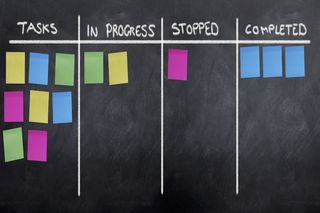Best agile tools
What tools do you need to embark on an agile project?

Sixteen years after the Agile Manifesto was created, agile is exploding in popularity, with more and more developers seeing the value in using agile to deliver software projects quickly while meeting customers' needs.
But which agile tool should you use? There's so many out there that it can appear daunting at first glance, but that doesn't mean you should just pick any. In fact, the right agile tool can change depending on the developer's particular requirements.
Each team of developers will look for different things in an agile tool, depending on factors like how close to agile their own way of working is and the size of the team. However, there are a few basic, consistent points to keep in mind.
Firstly, you want to keep it simple. Agile is about streamlining the development process to focus on the end result; the software. Make sure your agile tool doesn't add needless extra features or complexity that disrupts your workflow. As you run through sprints, you'll want a tool that lets you track project progress too, and one that helps you note down any user feedback or new feature requests as you deliver software to the customer. Another attractive aspect of a good agile tool is a function for reviewing sprints, so you can note any lessons to take forward into the next one.
We've covered what to look for in an agile tool, but which are the best ones? As we said above, your requirements will dictate what tool suits you best, but below we outline some of the most impressive ones currently available, for you to use as a starting point.
Taiga is an open source agile development tool that its creators say is a reaction to bloated, ugly software they had been stuck using
Who's it for? Agile developers, designers and project managers
Key features: Supports Scrum, Kanban and Epics project styles, simple and clean UX, almost fully customisable, users vote on upcoming features
Pricing: Free for up to 4 users, all the way up to $99 per month for 25 users
A web-based tool, Version One's strength lies in its focus on collaboration and scaling agile for a whole company, though the UI has room for improvement
Who's it for? SMBs and enterprises
Key features: Ability to scale, collaboration forums, user requests, management insight, integrates with enterprise tools and team tools
Pricing: Free trials, enterprise edition starts at $29.99
One of the most commonly used tools, according to Version One's 10th Annual State of Agile report, with 51% of respondents using it, JIRA lets you plan and track projects and improve team performance with real-time data
Who's it for? SMBs and enterprises
Key features: Trello-like Scrum boards, real-time sprint performance data, bug tracker, mobile apps, developer tool integrations
Pricing: $10 for up to 10 users, from $75 for 15 users
Pivotal Tracker gives teams one view of all their project priorities, and has workspaces that lets you view your projects side by side, as well as team analytics
Who's it for? Everybody from independent coders to enterprises
Key features: Automatic planning that encourages consistency, one view for entire project, workspaces for multiple projects, performance data, integrations with 140 apps,
Pricing: Free for up to three users, $12.50 and upwards for startups, $62.50 upwards for pro' users
This project management tool focuses on collaboration to help agile teams work more cohesively on Scrum projects, providing dashboards and conversations to keep everyone on track
Who's it for? Everybody from independent coders to enterprises
Key features: Project tracking, mobile app, real-time collaboration, goal-setting, multiple workspaces, team management
Get the ITPro. daily newsletter
Receive our latest news, industry updates, featured resources and more. Sign up today to receive our FREE report on AI cyber crime & security - newly updated for 2024.




